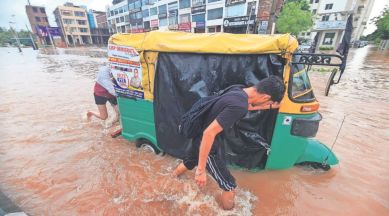Stay updated with the latest - Click here to follow us on Instagram
Man-made floods in Punjab | What exacerbated problem: vanishing choes, encroached water bodies, drains
Several videos of the house collapsing and being swept away in the floods in July went viral, shedding light on how water channels and drains have been unlawfully occupied by opportunistic developers in their haste to establish residential colonies.

As people, and probably its occupants, watched in horror, a house, built on the bank of a drain in Panchvati Enclave of Mohali’s Kharar collapsed like the proverbial house of cards. Several videos of the house collapsing and being swept away in the floods in July went viral, shedding light on how water channels and drains have been unlawfully occupied by opportunistic developers in their haste to establish residential colonies.
Kharar, located near Chandigarh and now a prime real estate location, bore the brunt of last month’s floods. Kharar’s population has grown considerably due to its proximity to the state capital, mostly owing to migration from rural areas. With burgeoning population came the demand for residential accommodation.
monthly limit of free stories.
with an Express account.
However, in the rush for unchecked urbanization, natural drainage systems and low-lying areas that were meant to accommodate rainwater were commandeered by profit-driven developers. Housing complexes and residences have mushroomed in Kharar as also in the other satellite colonies that have mushroomed in Punjab.
Given the dense urban population, the sewage infrastructure becomes overwhelmed during heavy rainfall. Furthermore, indiscriminate construction disrupts the natural flow patterns, exacerbating the problem. While sparse monsoons may have led developers to believe it’s acceptable to build over these drainage systems, heavy rains expose the fragility of the entire system.
Remarkably, the Department of Water Resources lacks a comprehensive count of these water bodies. Following the floods, a swift survey by the department indicated the existence of 66 “choes” (water bodies in the Kandi area). Unfortunately, the total count of man-made drains remains unavailable, though counting efforts are ongoing. The department has identified around 65 encroachments on water bodies and choes.
Noteworthy instances include Patiala Nadi in Patiala City, Kasur Nullah in Amritsar, and Budha Nullah in Ludhiana. Faced with limited data, the department plans to employ Geo Reference System (GRS) technology to pinpoint blocked drains and water channels. This transition is expected to take a few months. The department aims to identify problem areas and formulate policies accordingly.
However, during the recent Parliament session, Union Minister of State for Jal Shakti, Bishweswar Tudu, informed the Lok Sabha that according to the initial census, Punjab hosts 16,012 water bodies, with 1,578 encroached upon by individuals. This represents 10 per cent of the total, marking the highest encroachment rate in the region. While the union ministry acknowledges that addressing these encroachments falls under the state’s jurisdiction, it has consistently raised awareness among states about the significance of water bodies for socio-economic development.
While rivers like Sutlej, Beas, Ravi, and Ghaggar swell annually during the rainy season, various choes, nadis, and canals also channel rainwater. Floods occur in villages when there’s a breach in the embankments of these rivers and water channels. Breaches in the embankments of Sutlej, Beas, and Ghaggar rivers have led to flooding in dozens of villages this monsoon. The region comprising Jalandhar, Kapurthala, Hoshiarpur, and Nawashahr experienced water accumulation incidents due to heavy rain, affecting several villages, highways, and link roads situated along the embankment of these rivers and their tributaries. Similarly, in Patiala, overflowing Ghaggar river submerged several villages.
Encroachments on local drainage systems also contribute to village flooding. Village ponds, which historically help mitigate flood impact, have been illegally taken over. In 2020, the High Court directed the state government to clear these ponds of encroachments. The court set a six-month deadline for removal and mandated the government to restore, repair, renovate, and rejuvenate all village ponds. Additionally, orders were given to upgrade the revenue records pertaining to these ponds. The High Court observed that encroachers typically filled the ponds with soil before encroaching and constructing over them.
In 2021, lawyer activist HC Arora had moved the Punjab and Haryana High Court against failure to maintain village ponds in Punjab. He had stated that there were 15,000 ponds in Punjab out of which only 11,000 ponds remain while others have been encroached upon.
Former Rural Development and Panchayats Minister Tript Rajinder Singh Bajwa had started a campaign to clear these ponds of encroachments but nothing much came of it. The water bodies still stand usurped.
Punjab Water Resources Minister Gurmeet Singh Meet Hayer said that they are identifying these encroachments “We are in the process of preparing the database. This will help,” Hayer added. Leader of Opposition Partap Bajwa, said, “Punjab has 8,100 km of drains across the state. Every single drain has to be cleaned. The process should be monitored as a lot of bungling takes place. This should be stopped. Panchayats and ex-servicemen should be involved so that there is a check”.